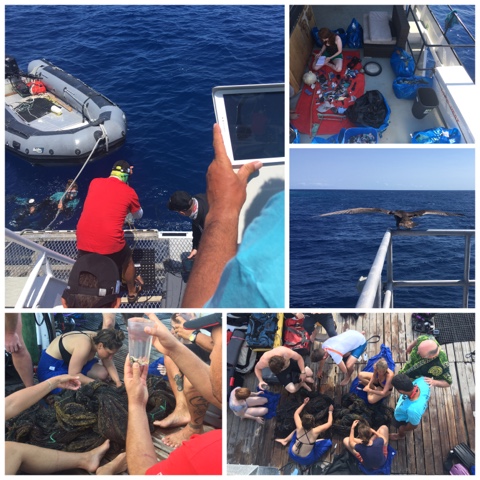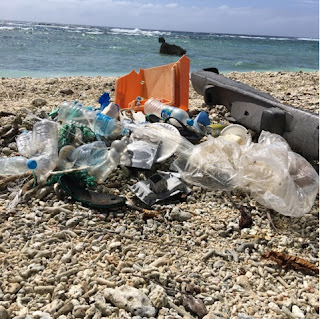Clipperton Expedition Day 9
Early morning up before anybody else, observed the captain and crew prepare to checkout another landing spot on the island.
The winds are expected to pickup starting tomorrow so the scientists will need to be collected today rather than tomorrow for safety concerns. They have all the equipment as well, we're all in anticipation of how it will all go.
I was hoping to go to the island for the flag raising with Michel and Julie, but for some reason they wanted to go with just a cameraman and another person. All good.
When the captain was back from dropping them off he was covered in sand! The boat flipped onto the beach apparently. That's where it seemed it was easier to drop, just like last time. Not sure there is an 'easy' landing spot. Still would've been great to see the airstrip and the flagpole. Anyway, yes safety.
Instead I ended up joining the dive focus of the expedition and diving in waters that are as clear as an aquarium, and full of life. Puffers, leatherbass, groupers, eels, box fish, trumpets, yellow jacks, squirrel fish, angel fish, blennies... Most captivating for me is the coralscape though, numerous in color and shape. There are many acropora but no table corals we can see within the first 80ft. Most are rock shaped, but havent seen any brain corals. We are strictly requested to remain above 80 because most of us are nearing our deco times. Safety is definitely first. We alotted time for 3 dives only today. There is a lot of macro shots that need to be taken on the reefs, but the current and surge arent very cooperative. Alex took the macro just for one dive, Im sure she got the beautiful gobies and blennies etc.
Surface interval means getting dry on the sun deck. I took a brief nap under the towels and woke up to a peculiar clicking/picking sound. Taking the towel off saw that I had a visitor boobie standing on the arm rest looking at me waking me up. When I got up with the towel in hand, he started screaming at me, I returned the call that sounds like 'whaaaack', he jumped onto the next chair. So so clumsy. He tried to fly out but couldnt fit through the handrails around the boat - you know cause he cant just flap his wings and rise up, hehe. 😂 He struggled to get up. Haha. Then when we were sitting above, he just landed on the handrail with wings spread out, as if telling the others not to come near. Or he was having his own Titanic moment. 😂
Back underwater for the final dive of the day there are many many eels. In one spot on our 3rd dive we named it eel central, right on the south east side of the island, going down between the rock and the first patch of coconut trees. My strobe died at the beginning of the third dive so all my images are through natural light. We recovered a very big fishing net that was covering a coral. Thankfully there were no fish and no dolphins or sharks caught on it, but we took it up. Had to attach 3 sausages and blast them all to raise it to the surface. The timing and location was perfect, just when our bottom time was about over and we were getting ready to head up. We did our safety stop watching the net and the birds plunging all around the safety sausages and checking us out. It's so funny how they stick their head in the water and look down at us undoubtedly going 'what on earth are you doing and what are all these bubbles we can spot you from a mile away!' Our pickup on the 3rd dive was rough due to the top current and winds and the net. We had to wait for the zodiax to get to us, every time it approached it got dragged away. Once we were aboard we saw another marker popup for the final 3 divers. They found anchors but couldnt lift them, they reported no hooks in the immediate area.
Once on the boat, Sandra, Meaghan and the rest of the scientists started to collect the life that was caught on it. Baby crabs, eels, nudibranchs, worms, fish and a few other life forms had started living in the net. It was down there for at least 2-3 years they said. But it is more dangerous to leave it down than pick it up, each day posing a risk to cetaceans, sharks and other reef fish.
The lines and nets are so many that we could have an expedition to just clear those with the entire crew just focused on that. It would take at least 20 days of being here proper to make a dent.
After the dives the expedition leaders launched the ROV to the depths together with Oscar and photographed by Alex in the water. The most curious about this expedition were the boobies, they were in the hundreds on the water around the ROV line watching it go down. The ROV went down only to 200feet to the plateau and couldnt go further, they only spotted 4 juvenile Galapagos and Silver Tips. No sign of hammerheads.
Well the water is at 29C/85-86F at 15-20meter depths... It is likely too warm for them. They're either deeper or just outside of the reef somewhere. We havent seen a single one.
In the morning and in between dives Meaghan and Sean spend their time counting and classifying all the plastics we got from the island. They have a method to the madness they say and will have it all sorted out before we leave at noon tomorrow. We cant leave all the stuff on the deck for the trip back, they'll easily be blown off back into the ocean.
We had another gorgeous sunset and then more shark biopsies. Though we were only was able to get 2, not many sharks around even at night time. There were two bigger ones, but too big for our line and platform to get them.
Then it was time to work on charging our cameras and clearing our SD cards to get ready for tomorrow's dives.
By 10pm it's lights out time to dream about out wonderful blue and it's amazing creatures.
Thank you for reading my experiences, please leave a comment if you want to know about something I havent mentioned. Stay with love with mother nature and our beautiful blue and wishing you a plastic free day! 💙🐬💙



Comments
Post a Comment